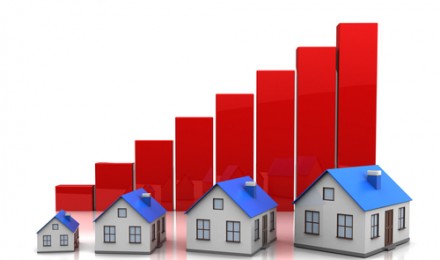The ongoing inventory shortage and a rise in home mortgage rates slowed the sales of previously owned homes in June. The pace of buying for existing home sales all completed transactions for single-family homes, townhomes, condominiums and co-ops, dropped 1.2 percent. This translates into an annualized pace of 5.08 million homes, according to a report released by the National Association of Realtors (NAR).
Year-over-year, sales are 15.2 percent above the 4.41 million-unit level recorded in June 2012. It’s the second strongest pace of demand since November 2009.
The NAR revised May’s existing home sales figure down to a rate of 5.14 million units. The 79 economists participating in the Bloomberg survey estimated a median forecast of 5.26 million homes, with a range of 4.99 million to 5.5 million units.
According to the report, the median price for previously owned homes increased 13.5 percent to $214,200 compared to $188,800 for the same period in 2012. Home prices have registered 16 straight months of year-over-year increases. The last time this happened was the period February 2005 to May 2006.
Inventory shortage
Lawrence Yun, NAR’s chief economist, describes momentum in the housing market as “strong.” Yun said, “The inventory shortage is continuing to push prices higher.”In June, the number of homes listed for sale rose 1.9 percent, to a supply of 2.19 million units. The current supply falls 7.6 percent below June 2012—a 6.4 month supply
This is the fewest number of homes for the month of June going back to 2001. First-time home buyers have experienced the most difficulty finding suitable properties. The most severe shortage of homes occur in the “affordable” price of $100,000 and below
Based on the current supply, it would take about 5.2 months to deplete the stock versus 5 months in May. “The inventory shortage is continuing to push prices higher,” said Yun. Yun forecast “above-normal price growth” due to the inventory shortage as the sellers’ market continue in many locations around the country.
Distressed property data
Fewer foreclosures and short sales transactions have played a key role in the housing market recovery. At 15 percent of total existing home sales transactions for June, it’s the lowest percentage share since the NAR begin tracking data in October 2008. Distressed property sales made up 26 percent of all transactions. Foreclosure sales comprised 8 percent and short sales 7 percent.
Over the last year, the steady decrease in distressed property sales has helped fuel home price appreciation. Distressed properties usually sell at a discount, but the price gap between distressed properties transactions and non-distressed property sales has greatly narrowed. In June, foreclosed homes sold for an average of 16 percent below average market value and short sales 13 percent less.
Other existing homes sales data
The rate of sales for single-family homes fell 1.1 percent to 4.5 million annualized rates. Fewer multifamily properties, which include condominiums, were purchased in June. This metric decreased 1.7 percent—falling to an annual pace of 580,000 units.
Sales in the Northeast and West dropped 1.6 percent. Purchases were also 1.5 percent lower in the South region and remained unchanged in the Midwest.
The market for existing home sales peaked in 2005–a record high of 7.08 million units. The resale home market continues to recover after plummeting to a 13-year low of 4.11 million units in 2008. In 2012, 93 percent of the residential market consisted of existing home sales.
The ongoing inventory shortage and a rise in home mortgage rates slowed the sales of previously owned homes in June. The pace of buying for existing home sales all completed transactions for single-family homes, townhomes, condominiums and co-ops, dropped 1.2 percent. This translates into an annualized pace of 5.08 million homes, according to a report released by the National Association of Realtors (NAR).
Year-over-year, sales are 15.2 percent above the 4.41 million-unit level recorded in June 2012. It’s the second strongest pace of demand since November 2009.
The NAR revised May’s existing home sales figure down to a rate of 5.14 million units. The 79 economists participating in the Bloomberg survey estimated a median forecast of 5.26 million homes, with a range of 4.99 million to 5.5 million units.
According to the report, the median price for previously owned homes increased 13.5 percent to $214,200 compared to $188,800 for the same period in 2012. Home prices have registered 16 straight months of year-over-year increases. The last time this happened was the period February 2005 to May 2006.
Inventory shortage
Lawrence Yun, NAR’s chief economist, describes momentum in the housing market as “strong.” Yun said, “The inventory shortage is continuing to push prices higher.”In June, the number of homes listed for sale rose 1.9 percent, to a supply of 2.19 million units. The current supply falls 7.6 percent below June 2012—a 6.4 month supply
This is the fewest number of homes for the month of June going back to 2001. First-time home buyers have experienced the most difficulty finding suitable properties. The most severe shortage of homes occur in the “affordable” price of $100,000 and below
Based on the current supply, it would take about 5.2 months to deplete the stock versus 5 months in May. “The inventory shortage is continuing to push prices higher,” said Yun. Yun forecast “above-normal price growth” due to the inventory shortage as the sellers’ market continue in many locations around the country.
Distressed property data
Fewer foreclosures and short sales transactions have played a key role in the housing market recovery. At 15 percent of total existing home sales transactions for June, it’s the lowest percentage share since the NAR begin tracking data in October 2008. Distressed property sales made up 26 percent of all transactions. Foreclosure sales comprised 8 percent and short sales 7 percent.
Over the last year, the steady decrease in distressed property sales has helped fuel home price appreciation. Distressed properties usually sell at a discount, but the price gap between distressed properties transactions and non-distressed property sales has greatly narrowed. In June, foreclosed homes sold for an average of 16 percent below average market value and short sales 13 percent less.
Other existing homes sales data
The rate of sales for single-family homes fell 1.1 percent to 4.5 million annualized rates. Fewer multifamily properties, which include condominiums, were purchased in June. This metric decreased 1.7 percent—falling to an annual pace of 580,000 units.
Sales in the Northeast and West dropped 1.6 percent. Purchases were also 1.5 percent lower in the South region and remained unchanged in the Midwest.
The market for existing home sales peaked in 2005–a record high of 7.08 million units. The resale home market continues to recover after plummeting to a 13-year low of 4.11 million units in 2008. In 2012, 93 percent of the residential market consisted of existing home sales.







